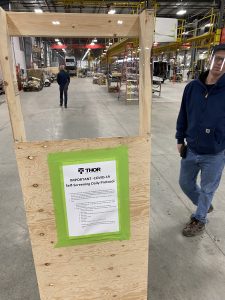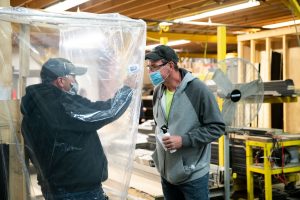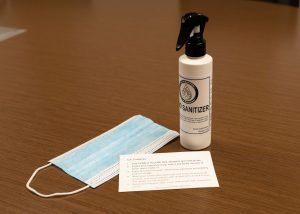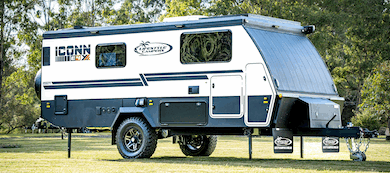COVID-19 One Year Later: From Shutdowns to Reopening to an Industry Boom
 March 11, 2020, the World Health Organization declared the novel coronavirus a global pandemic and gave it a name: COVID-19.
March 11, 2020, the World Health Organization declared the novel coronavirus a global pandemic and gave it a name: COVID-19.Editor’s note: This is Part Two of a two-part series regarding the impact COVID-19 had on the RV industry. Part One ran in Thursday’s eNewsletter. To access, that story, click here.
March 11, 2020, is the day the World Health Organization declared the novel coronavirus – also known as COVID-19 – a global pandemic.
By the time the one-year anniversary of that declaration rolled around, more than 2.6 million people around the globe and more than 530,000 Americans had perished from the lethal virus.
Aside from the horrific death toll, there wasn’t a business or industry in the United States that wasn’t affected in some way by COVID-19, some more than others. The travel, restaurant and entertainment industries suffered immensely – and a year later, are still a long way from recovering.
One could make the case, too, that the RV industry was impacted more than most by the pandemic. First, the entire industry basically shut down. Then, RVs proved useful as isolation habitats for doctors, nurses, first responders and others needing to quarantine, and as the preferred method of travel for those seeking a vacation.
New records were set in 2020 in terms of sales and units produced. And 2021 is predicted to be even bigger. This is poised to be the Year of the RV, Part Two.
COVID-19 had caught the eye of the industry – particularly on the manufacturing side – well before it became a household word in the U.S.
 “When the virus was very active in China, and they were going through shutdowns and stay-at-home orders, that affected our supply with importing certain material in, mainly for our vendors and our suppliers who import directly through partners overseas,” said Matt Zimmerman, group manager for THOR Industries. “So, we were concerned, naturally.”
“When the virus was very active in China, and they were going through shutdowns and stay-at-home orders, that affected our supply with importing certain material in, mainly for our vendors and our suppliers who import directly through partners overseas,” said Matt Zimmerman, group manager for THOR Industries. “So, we were concerned, naturally.”
By March, dealers were reporting to THOR that their lot traffic and even web traffic were down dramatically, as COVID-19 started dominating the headlines.
Not long after the WHO declaration, states began issuing stay-at-home orders.
“Because of what we do, we were actually deemed an essential business, but we really had to challenge ourselves: Does this make the most sense from a health and safety standpoint?” said Zimmerman, who oversees the Airstream, Keystone, Dutchmen, Crossroads and Thor Motor Coach brands for THOR. “We operate in different counties, we operate in different states, so the stay-at-home orders really were the triggers that forced us to shut down our facilities anywhere from seven to nine weeks.
“We made the conscious decision to shut down for the health and safety of our employees, and for us to figure out what’s next.”
The RV buying frenzy was still weeks away, as the country was reeling with a growing daily tally of deaths and much of the economy that had basically ground to a halt.
“Everyone was kind of in this, I call it ‘shock-and-awe moment,’” Zimmerman said. “People are just, ‘Wow, what just happened? We’re in shutdown – what does that mean?’ … Remember going to the grocery store? You couldn’t even find toilet paper, or you couldn’t find hand sanitizer, or you couldn’t find Clorox wipes. It was a moment of shock-and-awe for so many in American society, that first 30 days.”
RV Industry Association President Craig Kirby remembers it as a frantic time.
“I remember thinking at the time, ‘I don’t understand, the industry is shut down and I don’t think we’ve ever worked harder,’” he said last week. “I think everybody was putting in really long hours. … Go RVing was transitioning from our prior ad agency and was in the process of hiring a new ad agency, (then) finally got the new ad agency on board – remember, this was all done remotely – and what we had prepared for, the advertising material that we had prepared, had to totally change direction due to the pandemic. So, it was a crazy time … one day just seemed to meld into the other.”
No Playbook to Go By

Due to the shuttering of factories, furloughs were inevitable, at THOR and elsewhere. To try and minimize those, THOR President and CEO Bob Martin and his executive team all took steep pay cuts.
Meanwhile, the virus wasn’t going away, but THOR executives knew the plants would re-open sometime. It was time to plan.
“There was no blueprint that we could go to,” Zimmerman said. “We couldn’t pull it out of a filing cabinet and say this is what happened back in ’03, or 1999. … We leveraged our relationships with companies inside and outside of our industry to see what they were doing or what their plans were, to see what was working.”
That input, plus incorporating U.S. Centers for Disease Control and Prevention and local health officials’ advice, led company executives to develop a 27-page “‘Return to Work Handbook.”
They shared it with anyone who asked, according to Zimmerman.
“I’ll never forget my boss, Bob Martin, our CEO, telling us after we’ve been shut down for five or six weeks, ‘OK, we’re going in and we’re disinfecting every single plant.’ … We go in and we do a deep clean of restrooms and break rooms and then we execute the playbook from there. Which meant properly setting up our breakrooms, which would be removing tables, marking social distancing spots. …
“It was making sure we had PPE (personal protective equipment), for every single associate the day they return, which included face masks, a personal bottle of hand sanitizer, and a CDC health guideline card. All of those things. Making sure we took the temperature of every single associate every single day. But we did it in a fashion where they weren’t standing in line on top of each other for 20 minutes. Even thinking through the execution – our plants have 200 people in them, so how do we get 200 people lined up to do a temperature check every single morning? What happens when somebody has an elevated temperature? What’s the right protocol?”
Zimmerman estimates that THOR’s various manufacturing facilities have been fogged “over 1,000 times” since the pandemic, and he calls the amount of money spent on COVID prevention “astronomical.”
Still, the company also opened its wallet to outsiders who needed help.
“I can’t tell you how many masks (we donated). I can’t tell you how many units that we provided for testing sites. … Whether it was here (in Elkhart) or in Jackson Center, Ohio, or in Pendleton, Ore., we just rolled up our sleeves as a company and said we are going to be an example of how to navigate a pandemic. We just really went to work on it and I’m so proud of our team and what we’ve accomplished.”
Finally, around May, THOR and the rest of the OEMs started reopening their factories and producing coaches again. To this day, those manufacturers literally can’t build them fast enough.
Full Speed Ahead

“The nature of what we do as an industry was the right product at the right place at the right time to allow millions of Americans to kind of save their summer,” said Phil Ingrassia, president of the RV Dealers Association. “And certainly, we’re still seeing some of the after-effects of that with the projections of sales and shipments that we’ve seen come out over the last couple of weeks.”
Even with nearly two months of production lost, there were 430,412 total units shipped by manufacturers in 2020, representing a 6 percent increase over the previous year.
“Right, and don’t forget the final number of 515,000 units sold retail,” Ingrassia said. “So, it was an incredible year for sales – it was record-breaking. And considering so many weeks were lost, where there was very little retail activity; it just never stopped. And the projections kept going up, up, up, up, and then the fourth quarter blew everyone away, too, because it just didn’t stop. Overall, there was not a November/December lull in sales. They just kept going. So, that really powered the end of the year to get us to those lofty, half-a-million-sold sales numbers.”
Zimmerman said while the shutdown was going on, the THOR executive team speculated about what kind of year 2020 would end up being.
“No question, we had those type of conversations. We would have those conversations internally and then externally with our dealer partners,” he said. “I think everyone believed that the desire to purchase an RV would be there for a lot of consumers. … What we were really questioning, I think more than that, is would they have the means to do it? Would there be too much top-down economic pressure in terms of a recession that would prevent people from executing what they desired to do? That was probably the bigger concern.”
But execute they did. ITR Economics, which analyzes the industry for the RVIA, initially projected just over a half-million units would be shipped in 2021. In March that number was revised upward, to about 533,000.
“For as many people that we sold to last year, there was a bunch of people who didn’t do anything last year,” Ingrassia said. “So, you’re going to have a certain amount of pent-up demand from people who didn’t do anything in 2020 who’ll say, ‘I’ll be darned if I’m not going on vacation again this year. I’m getting an RV.’”

RVIA’s Kirby stressed the point that, as much as this pandemic ended up being a positive for the industry, his heart goes out to the families and friends of those whose lives were claimed by the pandemic – particularly those who were within the RV industry family.
That said, he’s proud of an industry that he has been serving in for nearly three decades.
“The bottom line is we all worked together to re-launch the industry,” Kirby said. “This is something that I don’t think is really recognized, is that, I don’t really know of any industry that could go from a complete stop to the production levels they did so quickly. You saw other industries struggle to come back on-board, and the way the RV industry – when it started back up – we were back up to close to full production very quickly. And the teams in the factories deserve a lot of credit for making that happen.”



